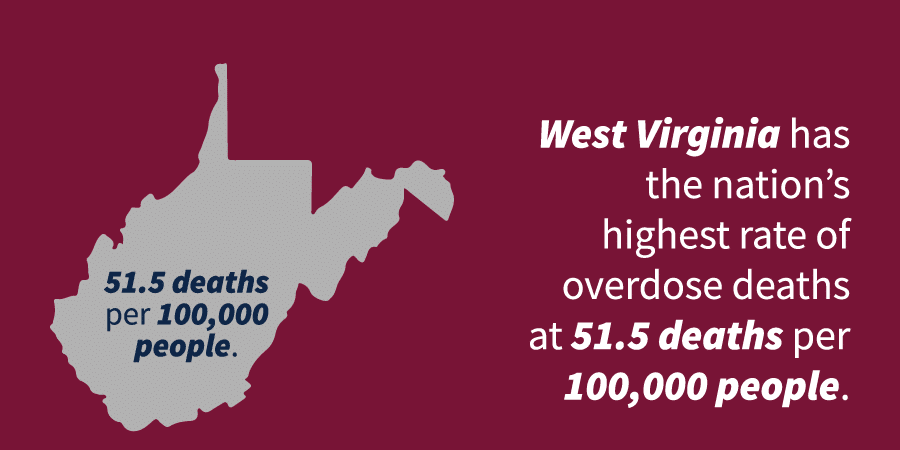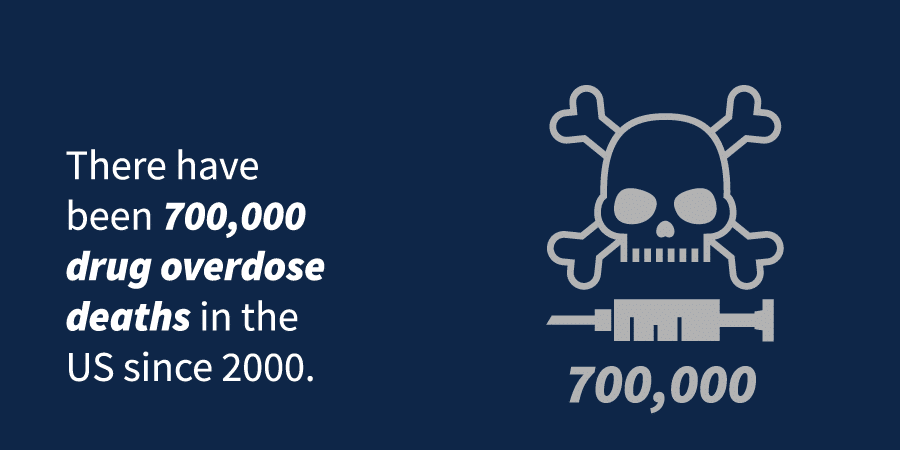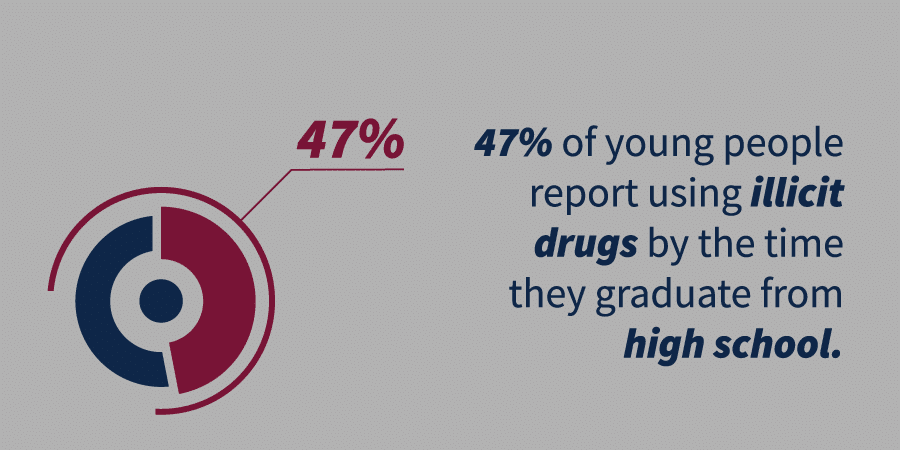Drug Use Statistics
Learn more in this article about the use of substances in the United States.

Drug Use Statistics
Learn more in this article about the use of substances in the United States.
Table of Contents
Statistics on Drug Addiction
Substance use disorder is a complex condition that impacts physical, social, behavioral, and emotional wellbeing. Addiction is characterized by the uncontrolled use of substances that has harmful consequences for that individual. Those who suffer from substance use disorders focus on a certain drug, such as alcohol, hallucinogens, tobacco, or stimulants.
When a substance becomes the center of a person’s life, it can have drastic impacts on their wellbeing and ability to participate in daily life functions. Sometimes, addiction can get in the way of work, school, and home life. Those who suffer from addiction will often continue to use the substance despite knowing that it’s causing or will cause problems in the future.1
Drug use statistics can help determine the prevalence and severity of addiction within a nation. Addiction statistics are important because they show that addiction isn’t a personal problem but an issue impacting hundreds of thousands of people.
According to the National Center for Drug Abuse Statistics, some of the major drug statistics to know about are as follows:
- There have been 700,000 drug overdose deaths in the US since 2000.
- 19.4% of all people have used illicit drugs at least once.
- There is a federal budget of $35 billion for drug control as of 2020.1
Quick Facts on Drug Addiction
Substance use disorders impact millions of people. Below are some quick drug use statistics that have been reported by the National Center for Drug Abuse Statistics.
- 11.7% or 31.9 million Americans aged 12 and above use illegal drugs.
- 19.4% or 53 million people ages 12 and over have used drugs or misused prescription drugs within the past year.
- Should alcohol and tobacco be included, 165 million or 60.2% of all Americans ages 12 and above currently abuse substances or have used them within the past 30 days.
- 8.1 million people now have a drug use disorder.1
The Dangers of Addiction
Causes of Addiction

There is never one cause of addiction. Instead, there are generally many factors contributing to the onset of addiction and the continuing use of substances. However, according to the National Institute on Drug Abuse, people generally began using drugs for the following reasons:
- People take substances to feel good, pleasure, or achieve a high.
- People take substances to feel better, such as relieving stress, forgetting problems, or feeling numb.
- People take substances to do better, improve performance, or improve their thinking.
- People take substances for sheer curiosity or to experiment.
- People take substances due to peer pressure.
Many individuals who use substances often suffer from another mental health disorder, such as anxiety, depression, or post-traumatic stress disorder. Also known as co-occurring disorders, being diagnosed with a mental health disorder and substance use disorder can be difficult to manage.
Those who suffer from substance abuse disorders may be aware of their problems, but they don’t know how to stop. Further, those who suffer from addiction may not want to stop or may not even have access to resources to get them the help they need to learn to cope with their addiction.
Most Commonly Abused Substances
According to drug use statistics, the most abused substances include:
- Alcohol
- Marijuana
- Painkillers, such as codeine and oxycodone
- Tobacco
- Hallucinogens, such as PCP and LSD
- Cocaine
- Methamphetamine
- Heroin1
While not illegal, alcohol and tobacco are the most commonly misused substances. According to statistics about drugs, there are 4.9 million new users of alcohol each year and 1.8 million new tobacco users each year.
Substance Abuse Statistics

Substance abuse statistics suggest that over 11.7% of all Americans 12 years or older have or do abuse substances. However, the breakdown of which substances are used and populations is essential for understanding addiction.
Drug Abuse Demographics
Drug abuse demographics describe the data related to the population and the particular groups that reside within it. Demographics can help to pinpoint which drugs are being used and by whom.
Drug use statistics indicate that some demographics and communities face an elevated risk of developing substance abuse and drug use disorders.
- Individuals who had previously misused substances and were recently released from prison are considered at a higher risk for overdose because their tolerance for that substance decreased while they were incarcerated.
- The most commonly misused substances among lower-income individuals include inhalants, such as paint thinners, gasoline, paint, and glue.
- 6.3 million LGBTQ+ individuals report a substance abuse disorder, mental health disorder, or both.
- Up to 7% of LGTBQ+ individuals report using illegal drugs.
- 2% of LGBTQ+ individuals report misusing alcohol.
- 8% of LGBTQ+ individuals report using illegal substances and misusing alcohol.
- 3% of LGBTQ+ individuals report a serious mental health disorder.1
Opioid Abuse
Opioids are a class of drugs that were initially designed to reduce pain. While there are some prescription opioids, others include synthetic fentanyl and heroin. Prescription drugs addiction statistics indicate that even opioids that a medical doctor prescribes can lead to addiction.
- 3.7% or 10.1 million of all Americans misuse opioids at least once over a year-long period.
- 1.6 million people qualify as having opioid use disorder.
- 9.7 million or 96.6% of opioid misusers use prescription pain relievers.
- Hydrocodone is the most popular prescription opioid and has 5.1 million misusers.
- Using opioids for longer than three months increases the risk of addiction by 15 times.1
Whether the drug is used via prescription or illegally, it has the same impact on the brain. Opioids work on the brain by reducing the brain’s pain signals, thus controlling emotion and breathing. Without proper monitoring by a medical doctor, the use of opioids can lead to addiction.
A Further Look: What Causes Opioid Addiction?
Alcohol Abuse
Alcohol is one of the most used substances and plays a significant role in societies and cultures worldwide. Even though alcohol is legal, statistics on alcohol indicate that it’s involved in the death of 95,150 Americans each year.
- Alcohol use rates indicate that 86.4% of people ages 18 or older drink alcohol at some point in their lifetime.
- 70.1% of people report drinking within the past year.
- 56% of people report drinking within the last month.
- Among the 15 million people who have been diagnosed with alcohol use disorder, fewer than 8% of people receive treatment for their addiction.
- Teen drug abuse stats indicate that teenagers ages 12 to 17 years old have increased their use of alcohol by 4.4% from 2018 to 2019.1
Cocaine Abuse
Drug statistics indicate that cocaine is very addictive.
- In 2018, 5.5 million people within the United States who were ages 12 and above reported using cocaine within the past year.
- In 2017, one in five drug overdose deaths were cocaine-related.
- Between 2012 and 2018, the rate of cocaine-related overdose deaths increased from 1.4% to 4.5%.1
Cocaine is a stimulant drug made from the leaves of the coca plant found in South America. This substance impacts the brain by increasing dopamine levels, which is a neurotransmitter involved in the reward center of the brain. Increasing this neurotransmitter can result in a high that causes extreme pleasure and happiness.2
Meth Abuse
Methamphetamine is a stimulant drug that impacts the brain by increasing dopamine levels. Because dopamine is involved in the brain’s reward pathway, it can induce a high and make an individual feel an intense pleasure response. However, methamphetamine is incredibly addictive and has several negative long-term side effects, including addiction, hallucinations, memory loss, paranoia, and brain structure and function changes.3
Substance abuse statistics show that:
Hallucinogens Addiction and Abuse
Hallucinogens can be naturally occurring and synthetic. Hallucinogens are illegal in the United States because they have no accepted medical use in treatment. Common hallucinogens include ketamine, mushrooms (psilocybin), LSD, and ecstasy (MDMA).
Some studies suggest hallucinogens can be addictive. Substance abuse statistics indicate that some people can develop a tolerance for hallucinogens. For instance, LSD, although not considered an addictive substance, can lead to drug-seeking behaviors, produce tolerance, and require its users to take an increasingly higher dosage to achieve the same high.4
Statistics On Hallucinogen Addiction and Abuse
Hallucinogens such as LSD, psilocybin, peyote, and DMT can influence the brain’s mood through representation, sleep, hunger, and more. More dissociative drugs can interfere with the brain’s chemistry and alter pain perception, responses to the environment, learning and memory, and emotion. While not all hallucinogens can result in overdose, some substances can have life-threatening adverse side effects.4
Statistics On Inhalant Addiction and Abuse

Inhalants are everyday products that, when used as intended, are harmless. Some more common inhalants include spray paints, felt tip markers, glue, and markers. However, it is essential to note that the vapors from these common products can be used to get high and can be toxic if misused. Statistics on drug abuse indicate that adolescents may intentionally misuse inhalants and suffer from negative side effects. Drug use statistics on inhalants include that:
- In 2015, nearly 684,000 teenagers ages 12 to 17 used inhalants within the past year.
- Teenagers are more likely than adults to have used inhalers in the past year to achieve a high.
- Female adolescents are more likely than males to use inhalants in the past month.
- The types of inhalants that adolescents use to achieve a high vary and include felt tip pens, markers, and magic markers.5
Commonly Abused Prescription Stimulants Include
Prescription stimulants are medications used to treat conditions such as attention deficit hyperactivity disorder (ADHD) and narcolepsy. Stimulants are characterized by their ability to increase alertness, increase attention, and increase the amount of energy a person has.6 A survey by the Partnership for Drug-Free Kids in 2014 found that about 20% of college students report abusing prescription stimulants.
Adderall
Adderall is a popular amphetamine that is typically used to treat ADHD. But according to teen drug abuse stats, Adderall is commonly misused. In fact, over 614,000 teens between the ages of 12 and 17 have reported misusing the drug. Prescription drug abuse stats indicate that the abuse of Adderall leads to nearly 1,500 emergency room visits every year, and it can have serious side effects, including insomnia and stroke.
Ritalin
Ritalin is another prescription stimulant that can be misused. It can have serious side effects, including hallucinations and a loss of appetite, but it can also serve as a gateway drug to more serious illicit substances.
Concerta
Concerta is a popular methylphenidate drug that is commonly abused by teenagers, according to teen drug abuse stats. This substance is commonly crushed and snorted to increase the impact of the high. Adverse effects of using Concerta include disruptive sleep, vision disturbances, and stroke.
Vyvanse
Although Vyvanse was initially thought to have low abuse potential, it has become a substance abused by adolescents. This substance was intended to be used by younger children and has serious side effects, including delirium, seizures, and abnormalities in brain chemistry.
Modafinil
Modafinil is a medication commonly prescribed for those diagnosed with narcolepsy but has begun to be used by teenagers. This substance can shut down the body’s need for sleep and be misused because students use it to study all night for exams.
The Consequences of Drug Abuse

Substance use is prevalent among different age groups, may have different prevalence among sex or gender, and can differ depending on location. Because drug abuse can vary, it’s important to track how substances are being used and the consequences of their usage. Drug use rates and statistics by demographic are discussed in the following sections.
Drug Abuse Among Age Groups
Statistics on drug abuse indicate a difference in substance addiction among different age groups. For instance, substance abuse statistics indicate that:
- 47% of young people report using illicit drugs by the time they graduate from high school.1
- Drug use is highest among those ages 18 to 25 at 39%, compared to those between the ages of 26 and 29, at 34%.1
- The prevalence of substance use among people aged 50 and older is low: about 2.6% report using marijuana in the past year, and 0.41% report using cocaine.7
- About 62% of individuals aged 65 and older used alcohol 30 days or more in a given year.
- 93% of college students who use illicit substances report using marijuana.1
- 35% of college students who use substances report using cocaine, and 36% report using hallucinogens.1
Drug Abuse Among States
Substance use may differ among the states. Drug use statistics indicate that some of the states with the highest drug overdose rates are in the western and midwestern states:8
- West Virginia has the nation’s highest rate of overdose deaths at 51.5 deaths per 100,000 people.
- Delaware: 43.8 deaths per 100,000 people.
- Maryland: 37.2 deaths per 100,000 people.
- Pennsylvania: 36.1 deaths per 100,000 people.
- Ohio: 35.9 deaths per 100,000 people.
Drug Abuse by Sex or Gender
Drug use statistics indicate that substance use may differ depending on the stacks or gender of an individual. For instance:1
- 22% of males report using drugs in the past year.
- 17% of females report using drugs in the past year.
- 18.5% of males report using marijuana, and 13.5% of females report using marijuana.
- 3.9% of the males report misusing painkillers, and 3.4% of females report misusing painkillers.
- 2.6% of males report misusing cocaine, and 1.5% of females report misusing cocaine.
- Only 20% of those in substance abuse treatment are female.
Drugs Death Rates
Drug death rates, namely accidental drug overdose, are the leading cause of death among individuals under the age of 45. Further, drug use statistics indicate:1
- Over 70,000 drugs deaths occur in the United States each year.
- The number of overdose deaths generally increases at 4% each year.
- From 2012 to 2015, there was a 264% increase in synthetic opioid deaths.
What is Fueling Drug Overdose Deaths?
Seeking Treatment

If you’re a loved one using substances and are experiencing the impacts of substance use disorders, seeking treatment is likely your best option. There are many options for treating substance use disorders, and mental health professionals are specifically trained to help those who suffer from addiction learn to cope with their substance use.
There are many rehabilitation options to choose from. While the most common are inpatient care, outpatient care, and therapies, residential treatment options are also available.
Inpatient Care
Inpatient care refers to the type of substance use disorder treatment that involves the individual remaining on-site 24/7. Those who undergo inpatient care receive around-the-clock services and assistance with substance use. These programs typically range from 30 days up to 90 days in length.
Outpatient Care
Outpatient care refers to when an individual comes to a treatment center to receive treatment. Instead of living at the treatment center, these individuals will come to the center specifically for group therapy or individual therapy.
Therapies
There are many therapy options available to help individuals recover from addiction. While some of the most common include cognitive behavioral therapy, solution-focused therapy, and dialectical behavioral therapy, many other types of therapy options are available.
Medication
Sometimes, medication can be used to help treat substance use disorders. Typically, medication can be used during the withdrawal period but can also be used for treatment and relapse prevention as well.
Medication for Withdrawal Symptoms
Some of the most common medications for withdrawal symptoms include:
- Antidepressants
- Benzodiazepines
- Clonidine
Medication for Relapse Prevention
Some of the medications commonly used to treat cravings and help with relapse prevention include:
- Naltrexone can help reduce heavy drinking.
- Acamprosate is commonly used to make staying away from the substance easier.
- Disulfiram can help people avoid drinking alcohol.
Resources
- https://drugabusestatistics.org/
- https://nida.nih.gov/publications/drugfacts/cocaine
- https://nida.nih.gov/publications/drugfacts/methamphetamine
- https://www.samhsa.gov/data/sites/default/files/report_3095/ShortReport-3095.html
- https://www.niaaa.nih.gov/publications/brochures-and-fact-sheets/treatment-alcohol-problems-finding-and-getting-help
- https://nida.nih.gov/publications/drugfacts/prescription-stimulants
- https://www.ncbi.nlm.nih.gov/pmc/articles/PMC3540205/
- https://www.cdc.gov/nchs/pressroom/sosmap/drug_poisoning_mortality/drug_poisoning.htm















